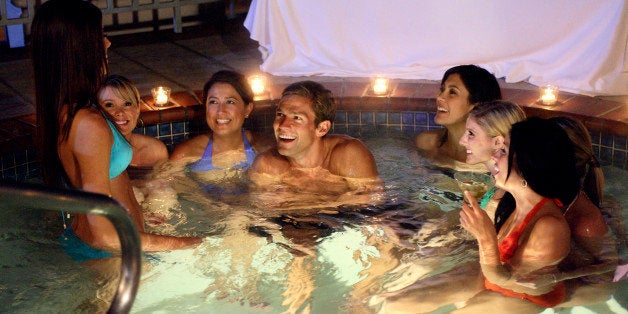
With warmer spring days and cooler nights upon us, plus summer vacations (hopefully) in the not-too-distant future, it's officially hot tub season. (Not to mention The Bachelorette starts back up again on Monday, meaning a summer full of steamy hot tub moments awaits on reality TV if not in actual real life.)
But while a soak in the hot tub may sound relaxing, is it hygienic? Does shaking in a few chemicals actually do the trick? We turned to a couple of experts -- Michele Hlavsa, RN, MPH, an epidemiologist and chief of healthy swimming for the Centers for Disease Control of Prevention and Charles Gerba, Ph.D., a professor of microbiology and environmental studies at The University of Arizona -- to find out.
It turns out, you can pick up some unappetizing and even dangerous bugs from a hot tub dip, both from the water itself and also from the steamy atmosphere around it. Unlike a pool, the warmer temperature of a hot tub makes it more difficult to maintain the proper disinfectant levels that kill certain germs, Hlavsa explains. One common germ is Pseudomonas aeruginosa, which can result in an infection called Pseudomonas folliculitis, or the aptly-chosen nickname, "hot tub rash."
Pseudomonas aeruginosa is commonly found in water and soil, and multiplies in the water when disinfectant levels dip. When those disinfectant levels shoot back up again, it doesn't necessarily disappear. "At that point it stays in the water and waits for the level to come down again to multiply," Hlavsa says. "People tend to sit in hot tubs for a while, so their skin is exposed to contaminated water for a while."
The rash often follows the shape of a person's bathing suit, and is characterized by itchy spots that develop into a bumpy rash, as well as pus-filled blisters around hair follicles, according to the CDC -- symptoms usually crop up within a few days of exposure.
While hot tub rash typically clears up on its own without treatment, another more serious condition to be aware of is the potentially fatal Legionnaires’ disease, a type of pneumonia caused by a germ called Legionella, which is found in water (especially warm water) and can be breathed in from the steam or mist surrounding a contaminated hot tub -- people older than age 50, smokers and those with weakened immune systems are particularly susceptible. Legionella, which protects itself in the water similarly to the way Pseudomonas aeruginosa does, Hlavsa says, can also cause a milder, flu-like illness called Pontiac fever.
According to the CDC's most recent outbreak report, released earlier this year, 16 outbreaks related to hot tubs and spas were reported to the CDC in 2009-2010 -- 43.8 percent of them were suspected or confirmed to be caused by Pseudomonas, and 25 percent were confirmed to be caused by Legionella.
On top of pathogens that can naturally be found in water, humans also introduce their own share of germs when they slip into a hot tub. "The average bather has about a tenth of a gram of feces in his gluteal fold, which is a nice way of saying butt crack," Gerba says. That means with five people, "you have a tablespoon of poop in the hot tub." And beyond the gross-out factor, without safe levels of disinfectant, you can run the risk of transmitting diseases, he says.
Another concern is people urinating in the hot tub (while exact numbers are difficult to pinpoint for hot tubs specifically, one poll found that one in five Americans copped to peeing in a swimming pool). When urine (and other waste, such as sweat) mixes with chlorine, it creates an irritant called chloramine, which is what causes red, stinging eyes when swimming and can also irritate your respiratory tract, Hlavsa explains. "It's really important to not use the hot tub as a restroom," she says. (Chloramines are also what causes that "chlorine smell," which is a red flag for contamination.)
While many people shower after swimming, it's key to bathe before you get in the hot tub, too -- personal care products such as lotion, makeup and sunscreen use up the disinfectant in the water, meaning it's less able to kill off other bugs. "If three people jump in the hot tub right away the disinfectant level drops," Gerba says -- for that reason, he tries to be in the hot tub with as few people as possible, which decreases the demand for disinfectant.
So what's a hot tub lover to do? Don't leave your swim up to chance: Hlavsa recommends buying a set of test strips at your local pool supply store (they typically cost less than $10 for 50 strips, she says) so you can know if the water is safe before you hop in. "You just dip them into the water before you get in," she says. "The pads change colors and by the different colors you can judge the different disinfectant." The CDC recommends a water chemistry that looks like this: chlorine at 2–4 mg/L or parts per million (ppm) or bromine at 4–6 ppm and a pH between 7.2 and 7.8. The hot tub should have smooth tiles, no odor and a temperature that doesn't exceed 104 degrees F. And always avoid getting the water in your mouth. Check out more hot tub safety tips from the CDC here.
"It's like anything else," Hlavsa says, "you just do it in the healthiest way possible."